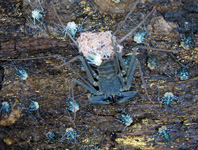Abstract
The new, small cavernicolous species Helmablatta louisrothi gen. et sp. n. (Nocticolidae) from the Tan-Phu cave (Vietnam) is one of the most morphologically interesting cockroaches. The extremely modified upstanding tergal gland composite from three tergites and may serve for gripping the female head during copulation. This presumption is supported by the presence of a central big hook on tergite 8. Furthermore, both wing pairs are uncommonly adapted to help releasing sex pheromones without raising the wings. Histone 3 DNA-based maximum likelihood analyses indicate a recent origin and close phylogenetic relationship between Nocticola spp. and Helmablatta sp.—consistent with the Quaternary age of the source lava tubes.
References
Alexander, R.D. & Otte, D. (1967) The Evolution of Genitalia and Mating Behavior in Crickets (Gryllidae) and other Orthoptera. Miscellaneous publications, 133 (Museum of Zoology, University of Michigan), 1‒62.
Bell, W.J., Roth, L.M. & Nalepa, C.A. (2007) Cockroaches Ecology, Behavior, and Natural History. The Johns Hopkins University Press, Baltimore, 230 pp.
Djernaes, M., Klass, K-D., Picker, M.D. & Damgaard, J. (2012) Phylogeny of cockroaches (Insecta, Dictyoptera, Blattodea), with placement of aberrant taxa and exploration of out-group sampling. Systematic Entomology, 37, 65‒83.
https://doi.org/10.1111/j.1365-3113.2011.00598.x
Djernaes, M., Klass, K-D. & Eggleton, P. (2015) Identifying possible sister groups of Cryptocercidae + Isoptera: A combined molecular and morphological phylogeny of Dictyoptera. Molecular Phylogenetics and Evolution, 84, 284‒303.
https://doi.org/10.1016/j.ympev.2014.08.019
Fisk, F.W. (1977) Notes on cockroaches (Blattaria) from caves in Chiapas, Mexica and environs with descriptions of three new species. In: Subterranean Fauna of Mexico, Part III. Problemi Attuali di Scienza e di Cultura, Quaderno N. 171. Accademia Nazionale dei Lincei, Roma, pp. 267‒274
Golovatch, S.I., Geoffroy, J.-J., Mauriès, J.-P. & Van den Spiegel, D. (2009) Review of the millipede genus Plusioglyphiulus Silvestri, 1923, with descriptions of new species from Southeast Asia (Diplopoda, Spirostreptida, Cambalopsidae). Zoosystema, 31 (1), 71‒116.
https://doi.org/10.5252/z2009n1a5
Huson, D.H. & Bryant, D. (2006) Application of Phylogenetic Networks in Evolutionary Studies. Molecular Biology and Evolution, 23, 254‒267.
https://doi.org/10.1093/molbev/msj030
Hutson, A.M., Mickleburgh, S.P. & Racey, P.A. (Comp.) (2001) Microchiropteran bats: global status survey and conservation action plan. IUCN/SSC Chiroptera Specialist Group. IUCN, Gland & Cambridge, x + 258 pp. [ISBN: 2-8317-0595-9]
Inward, D., Beccaloni, G. & Eggleton, P. (2007) Death of an order: a comprehensive molecular phylogenetic study confirms that termites are eusocial cockroaches. Biology Letters, 3, 331‒335.
https://doi.org/10.1098/rsbl.2007.0102
Klass, K.-D. & Meier, R. (2006) A phylogenetic analysis of Dictyoptera (Insecta) based on morphological characters. Entomologische Abhandlungen, 63, 3‒50.
Laumanns, M. (2013) Important lava tube caves found in Dong Nai Province, Southern Vietnam. e-Newsletter U.I.S. Commission on Volcanic Caves, 67, 13‒15.
Laumanns, M. (2014) Karst and Caves of South Vietnam. Part 2: Provinces of Dong Nai, Lam Dong and Quang Tri. Berliner Höhlenkundliche Berichte, 56, 1‒49.
Lo, N., Beninati, T., Stone, F., Walker, J. & Sacchi, L. (2007) Cockroaches that lack Blattabacterium endosymbionts: the phylogenetically divergent genus Nocticola. Biology Letters, 3, 327‒330.
https://doi.org/10.1098/rsbl.2006.0614
Mullins, D.E. & Keil, C.B. (1980) Paternal investment of urates in cockroaches. Nature, 283, 567‒569.
Nojima, S., Sakuma, M., Nishida, R. & Kuwahara, Y. (1999) A glandular gift in the German cockroach, Blattella germanica (L.) (Dictyoptera: Blattellidae): The courtship feeding of a female on secretions from male tergal glands. Journal of Insect Behavior, 12, 627‒640.
https://doi.org/10.1023/A:1020975619618Ronquist, F. & Huelsenbeck, J.P. (2003) MrBayes 3: Bayesian phylogenetic inference under mixed models. Bioinformatics, 19, 1572‒1574.
https://doi.org/10.1093/bioinformatics/btg180
Roth, L.M. (1967) Uricose glands in accessory sex gland complex of male Blattaria. Annals of the Entomological Society of America, 60, 1203‒1211.
Roth, L.M. (1969) The evolution of male tergal glands in the Blattaria. Annals of the Entomological Society of America, 62, 176‒208.
Roth, L.M. (1988) Some cavernicolous and epigean cockroaches with six new species, and a discussion of the Nocticolidae (Dictyoptera: Blattaria). Revue Suisse de Zoologie, 95, 297‒321.
https://doi.org/10.5962/bhl.part.79654Roth, L.M. (2003) Systematics and phylogeny of cockroaches (Dictyoptera: Blattaria). Oriental Insects, 37, 1–186. https://doi.org/10.1080/00305316.2003.10417344
Roth, L.M. & Dateo, G.P. (1964) Uric acid storage and excretion by accessory sex glands of male cockroaches. Journal of Insect Physiology, 11, 1023‒1029.
https://doi.org/10.1016/0022-1910(65)90205-2Smrž, J., Kováč, Ľ., Mikeš, J. & Lukešová, A. (2013) Microwhip scorpions (Palpigradi) feed on heterotrophic cyanobacteria in Slovak caves—a curiosity among Arachnida. PLoS ONE, 8 (10), e75989.
https://doi.org/10.1371/journal.pone.0075989
Sreng, L. (1993) Cockroach mating behaviors, sex pheromones, and abdominal glands (Dictyoptera, Blaberidae). Journal of Insect Behavior, 6, 715‒735.
https://doi.org/10.1007/BF01201672Svenson, G.J. & Whiting, M.F. (2004) Phylogeny of Mantodea based on molecular data: evolution of a charismatic predator. Systematic Entomology, 29, 359‒370.
https://doi.org/10.1111/j.0307-6970.2004.00240.x.
Svenson, G.J. & Whiting, M.F. (2009) Reconstructing the origins of praying mantises (Dictyoptera, Mantodea): the roles of Gondwanan vicariance and morphological convergence. Cladistics, 25, 1‒47.
https://doi.org/10.1111/j.1096-0031.2009.00263.x
Tamura, K., Stecher, G., Peterson, D., Filipski, A. & Kumar, S. (2013) MEGA6: Molecular Evolutionary Genetics Analysis Version 6.0. Molecular Biology and Evolution, 30, 2725‒2729.
https://dx.doi.org/10.1093/molbev/mst197
Tian, M.-Y. (2011) A new cave-dwelling species of the genus Itamus Schmidt-Göbel (Insecta: Coleoptera: Carabidae: Paussinae) from Southern Vietnam. Entomotaxonomia, 33 (2), 112‒117.
Vidlička, Ľ., Vršanský, P. & Shcherbakov, D.E. (2003) Two new troglobitic cockroach species of the genus Speleoblatta (Blattaria: Nocticollidae) from North Thailand. Journal of Natural History, 37, 107‒114.
https://doi.org/10.1080/713834390Wei, D. & Ren, D. (2013) Completely preserved cockroaches of the family Mesoblattinidae from the Upper Jurassic-Lower Cretaceous Yixian Formation (Liaoning Province, NE China). Geologica Carpathica, 64, 291‒304.
https://doi.org/10.2478/geoca-2013-0021
Whiting, M.F., Bradler, S. & Maxwell, T. (2003) Loss and recovery of wings in stick insects. Nature, 421, 264‒267.
https://doi.org/10.1038/nature01313

